
Central do Brasil is a major train station in the Brazilian city of Rio de Janeiro. It is the last stop of Rio's railway network, as well as a hub for connection with the city subway and a bus station. Central do Brasil was also a preeminent stop in the interstate Central do Brasil railroad, which linked Rio de Janeiro with São Paulo and Minas Gerais, though the railroad is now deactivated. The station is located in downtown Rio de Janeiro, along the Avenida Presidente Vargas and across from the Campo de Santana park. It was built in the Art Deco style.
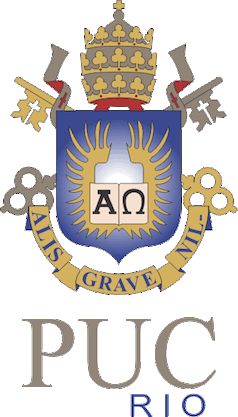
The Pontifical Catholic University of Rio de Janeiro is a Jesuit, Catholic, pontifical university in Rio de Janeiro, Brazil. It is the joint responsibility of the Catholic Archdiocese of São Sebastião do Rio de Janeiro and the Society of Jesus.

The Theatro Municipal is an opera house in the Centro district of Rio de Janeiro, Brazil. Built in the early twentieth century, it is considered to be one of the most beautiful and important theaters in the country.
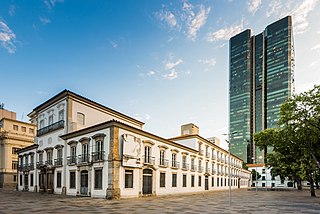
The Paço Imperial, or Imperial Palace, previously known as the Royal Palace of Rio de Janeiro and Palace of the Viceroys, is a historic building in the center of the city of Rio de Janeiro, Brazil. The Paço Imperial was built in the 18th century to serve as a residence for the governors of colonial Brazil. From 1808, it was used as a royal residence by King John VI of Portugal as King of Portugal and later also as King of Brazil. In 1822 it became the city palace of the monarchs of the Empire of Brazil, Pedro I and Pedro II, who used it not as a residence, but as a workplace. It was one of the main political centers of Brazil for nearly 150 years, from 1743 to 1889.

The Gustavo Capanema Palace, also known architecturally as the Ministry of Education and Health Building, is a government office building in the Centro district of Rio de Janeiro, Brazil. As the first modernist project in Brazil, it is historically important to the architectural development of Modernism in Brazil and has been placed on Brazil's UNESCO tentative list.

Cinelândia is the popular name of a major public square in the centre of Rio de Janeiro, Brazil. Its official name is Praça Floriano Peixoto, in honour of the second president of Brazil, Floriano Peixoto.
Vila Vintém is an urban low income living community located between the neighbourhoods of Realengo and Padre Miguel, in the West Zone of the city of Rio de Janeiro. Situated on the borders of the railroad, it shelters the headquarters of Mocidade Independente de Padre Miguel and also Unidos de Padre Miguel, as well as many of their components. Its principal road is called Rua Belisário de Souza, that goes from the ensemble of IAPI, in Padre Miguel, until Realengo.

The Federal Rural University of Rio de Janeiro is a public university located in Seropédica in the State of Rio de Janeiro, Brazil. It possesses the largest campus among Latin American universities and is known for being the first university to offer agriculture related courses in Brazil.

Avenida Santa Fe is one of the principal thoroughfares in Buenos Aires, Argentina. The artery is essential to the imaginary axis of Barrio Norte in Buenos Aires, comprising the areas influenced by the route of the avenue through Retiro, Recoleta and Palermo neighborhoods, it is considered one of the main shopping and strolling areas of the city, its many boutiques range from elegant to edgy, which has led it to be dubbed the 'Avenue of Fashion'. Upscale Alto Palermo, at Avenida Coronel Díaz, is one of the city's best-known vertical malls. Avenida Santa Fe is also an attraction for its architecture, strongly reminiscent of Paris. Its name pays homage to the eponymous province in Argentina.

Rio Branco Avenue, formerly Avenida Central, is a major road in downtown Rio de Janeiro. It was built as the leading brand of the urban reform carried out by the mayor Pereira Passos in early 20th century.

Castelo is a region in Rio de Janeiro, Brazil, but not officially recognized as a neighborhood, and officially forms part of the Centro neighborhood. It is generally considered to be located in the region between Avenida Rio Branco, the Santos Dumont Airport and Praça Quinze de Novembro. The area derives its name from the former Morro do Castelo in that location, which was demolished by water jets in the 1920s. As most of the buildings in the area were designed and built in the first half of the twentieth century, after the demolition of Morro do Castelo in 1921, the region became home to a large collection of Art Deco buildings. Art Deco was the prevalent architectural style in Rio de Janeiro at that time.
Aldeia Campista was a neighborhood in Rio de Janeiro, Brazil, close to contemporary Vila Isabel, Tijuca, Maracanã and Andaraí.

Avenida Brasil is an expressway-like thoroughfare in Rio de Janeiro. Its emergence is associated with the expansion of the city to residential areas further away from its central region during the first half of the 20th century. It started to serve as a gateway by road, hitherto hitched by sea or by the path taken by trains. The avenue that was linked to Petrópolis in 1941 became the first federal highway (BR-01) in 1948.
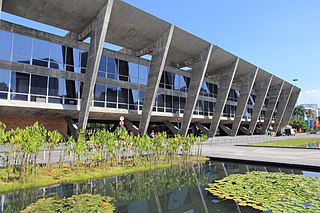
The Museum of Modern Art of Rio de Janeiro is a museum located in northeastern Flamengo Park, in the city of Rio de Janeiro, Brazil. It is in the Centro district, west of Santos Dumont Airport, on Guanabara Bay.
Praia do Abricó is a nude beach located in Grumari, a sub district of Barra da Tijuca neighborhood, in the western part of the city of Rio de Janeiro, Brazil. It is currently the only beach that permits the practice of naturism in the city. It is officially affiliated to the Brazilian Federation of Naturism (FBrN).
The following is a timeline of the history of the city of Rio de Janeiro, Brazil.
Vila Kennedy is a neighborhood and favela in the western zone of Rio de Janeiro. It is located on the fringes of Avenida Brasil. Its streets have the names of African and Asian countries, as well as musicians. Before being an official neighborhood it was a part of Bangu before being separated into its own neighborhood by law in July 2017.

Pontal is a small peninsula and beach area in the Recreio dos Bandeirantes neighborhood, located in the West Zone of Rio de Janeiro, Brazil and was a temporary venue in the Barra Olympic venues cluster for the Athletics and Cycling competitions of the 2016 Summer Olympics.
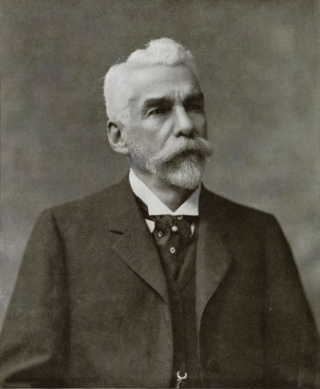
Francisco Pereira Passos was a Brazilian civil engineer and politician. He was mayor of the Federal District of Brazil from 1902 to 1906, nominated by President Rodrigues Alves. During his tenure, Pereira Passos promoted a large-scale urban renewal plan for Rio, inspired by Georges-Eugène Haussmann's renewal of Paris.
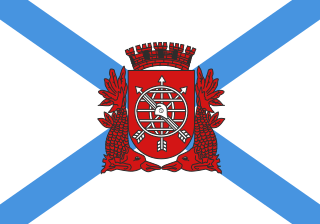
The following outline is provided as an overview of and topical guide to Rio de Janeiro:
















